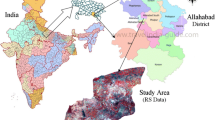Abstract
Runoff is one of the important hydrologic variables used in most of the water resources applications. The Soil Conservation Service-Curve Number (SCS-CN) method is adopted for the estimation of surface runoff in the Mehadrigedda watershed area, Visakhapatnam district, India using multispectral remote sensing data, curve number approach and normal rainfall data. The main source of water in the Mehadrigedda watershed area is by rain, most of it drains off and only a little percolates into ground. The weighted curve number is determined based on antecedent moisture condition (AMC)-II with an integration of hydrologic soil groups (HSGs) and land use/land cover LULC categories. An integrated approach is applied to delineate the land use/land cover information as adopted from NRSA classification. The recording of daily rainfall data during the years 1997–2006 is collected from Indian Meteorological Department (IMD) rainguage center at Kottavalasa. It is observed that the annual rainfall-runoff relationship during 1997–2006, which is indicating that the overall increase in runoff with the rainfall of the watershed area. Integration of remote sensing (RS) and geographical infomation system (GIS) techniques provide reliable, accurate and up-to-date information on land and water resources.
Similar content being viewed by others
References
Ambazhagan S, Ramaswamy SM and Das Gupta S (2005) Remote sensing and GIS for artificial recharge study, runoff estimation and planning in Ayyar basin, Tamil Nadu, India. Environ Geol 48(2): 158–170
Arc GIS (2004) GIS software, verson 9.0. Environmental Systems Research Institute (ESRI), New York
Chow VT (1964) Handbook of Applied Hydrology. McGraw Hill, New York
Durbude DG, Purandara BK and Sharma A (2001) Estimation of surface runoff potential of a watershed in semi arid environment — A case study. J Indian Soc Remote Sens 29(1&2): 48–58
ERDAS IMAGINE (2003) Digital Image Processing Software, version 8.7. Leica Geosystems & GIS Mapping, Atlanta, U.S.A
Jasrotia AS and Singh R (2006) Modeling runoff and soil erosion in a catchment area, using the GIS, in the Himalayan region, India. Environ Geol 51: 29–37
McCuen RH (1982) A Guide to hydrologic analysis using SCS methods. Prentice-Hall Inc., Englewood Cliffs, New Jersey
Narayana DVV (2002) Soil and Water Conservation Research in India. Indian Council of Agricultural Research, New Delhi
Narendra K and Rao KN (2006) Morphometry of the Mehadrigedda watershed, Visakhapatnam district, Andhra Pradesh using GIS and Resourcesat data. J Indian Soc Remote Sens 34(2): 101–110
Rao KN and Narendra K (2006) Mapping and evaluation of urban sprawling is the Mehadrigedda watershed in Visakhapatnam metropolitan region using remote sensing and GIS. Current Science 91(11): 1552–1557
Schwab GO, Fangmeier DD, Elliot JW and Frevert KR (2002) Soil and Water Conservation Engineering. John Wiley & Sons, New York
SCS (1985) National Engineering Handbook. Section 4-Hydrology. United States Department of Agriculture Soil Conservation Service, Washington, DC
Thornthwaite CW and Mather JR (1957) Instruction and tables for computing potential evapotranspiration and water balance. Laboratory of Climatology. 8: 104
Tripathi MP, Panda RK, Pradhan S and Sudhakar S (2002) Runoff modeling of a small watershed using satellite data and GIS. Jour Indian Soc Remote Sensing 30(1&2): 39–52
USDA (1986) Urban hydrology for small watersheds. Technical Release 55(TR-55). United States Department of Agriculture, Washington, DC
Zade M, Ray SS, Dutta S and Panigrahy S (2005) Analysis of runoff pattern for all major basins of India derived using remote sensing data. Current Science 88(8): 1301–1305
Author information
Authors and Affiliations
Corresponding author
About this article
Cite this article
Rao, K.N., Narendra, K. & Latha, P.S. An integrated study of geospatial information technologies for surface runoff estimation in an agricultural watershed, India. J Indian Soc Remote Sens 38, 255–267 (2010). https://doi.org/10.1007/s12524-010-0032-8
Received:
Accepted:
Published:
Issue Date:
DOI: https://doi.org/10.1007/s12524-010-0032-8




